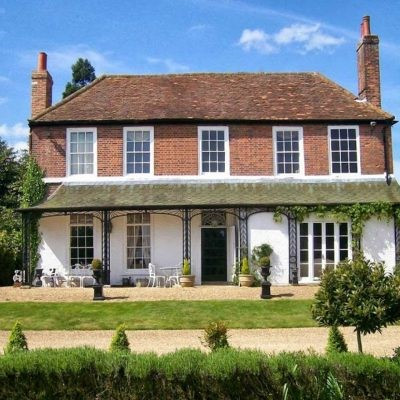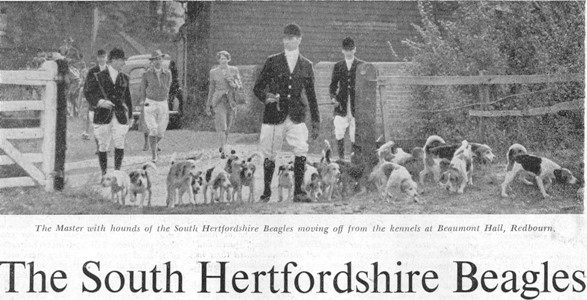Beaumont Hall Farm

There are records of many different spellings of the name, including Bedmond, Beemont and the earliest Bedmondlane. (1424). The first farm can be traced to around 1454, when Robert Derant paid a rent of 10 shillings for a tenement. By 1486, Richard Benet paid 50 Shillings for lands, now referred to as a farm to the Prioress of Praye. The manor of Beamonde was mentioned again in 1528, when the Order of Nuns held an investigation. . By 1534 the manor was recorded as having 10 acres. This second manor created for the Priory at its foundation was the Manor of the Priory or St Amphibals Manor. It was valued at the Dissolution by the Court Of Augmentation in 1540 at £2 13s 4d.
In 1551, John Cokkys exchanged the land for some in Windridge with Lord Clinton. Then in 1558 manor and the site of the Redbourn Priory were sold to Richard Rede. The farm by then had around 12-16 acres with a farmhouse named Green Tree. Holders of the land then included Innocent Rede (1568-97) Richard Rede (1597-1614), he then sold it to William Cavendish (1614-1628) Thomas Saunders (1628-1637) then to William Beaumont of Stanfield, Norfolk .By then the farm had customary tenants with holdings. These included areas noted under separate names – Ivings, Ponds Hearne, the Brache, Half Acre, Sheppards Croft, Priors Croft, Dudley Field, Beech Field and Mill Field ( indeed many that we know today from local street names).
In 1642 the farm was described as consisting of ‘a faire mansion house and diverse barns, stables and other houses. ‘An orchard and two gardens’. The main hall was left to William’s wife – Martha, on his death in 1661, and the rest of the estate to his son-in-law Eignon Beynon. Martha died in 1673 and Eignon in 1707. The estate then passed to his son of the same name. The size of the farm gradually increased as they bought lands that edged the estate, but in order to do so, Eignon the second took out a mortgage on it. By 1715, he was describing himself as of Beaumont Hall.
In the church, there is a bust of Mary Beynon, who died in 1731. She was the widow of Eignon Beynon of Beaumont Hall who died in 1733. His son, Thomas, increased the mortgages even more and was sadly certified as a lunatic, he surrendered the Hall in 1752 when William Howard was living there. By then the estate has grown to 112 acres. Because of his health, the Court Of Chancery took over Thomas’s affairs and the leased the Hall to John Goulds for 21 years at a rate of £400 p.a. One Thomas Darker actually lived at the Hall and the land was farmed by William Howard. In 1760, Darker bought the estate for £11,400, selling it in 1774 to Joseph Banks of Lincoln’s Inn for £15,750. By 1775 Viscount Grimston was the owner. The estate consisted of two houses with outbuildings. four barns, 100 acres of land, 12 acres of meadow, 10 acres of pasture, 6 acres of wood, 12 acres of heathland was owed £6 in rents. By 1816 it was a farm of 235 acres, a description in a survey ordered by the Viscount notes ‘thee buildings consist of a brick and tiled dwelling house, a stable and granary with loft over, Brewhouse and pantry, all brick and tile. A wheat barn, (two bays) an oat barn (five bays), wood house, hen house (of timber and thatch). A beer cellar under the house. In a farther yard are a barley barn (four bays) sheephouse, cattle stalls, cartshed, a stable and cottage and also another cottage of brick and tile’. In the 1851 census, Beaumont Hall, occupied by George Webb had become the largest farm in the parish it had 553 acres.
Beaumont Hall is also noted as having the first identifiable school in Redbourn. In 1771, an advert appeared in the ‘Public Advertiser’
‘Youths from 5 to 16 years of age are boarded and taught English, Latin and French; Writing in all hands ; Arithmetic, in all parts; Mensuration, Surveying, Gauging, Dialling etc., with several branches of the Mathematics, and Book –Keeping.’
There were 43 boarders at that time, with schooling and boarding costing £14 per annum, ‘Mending and School Articles ‘were an extra £16 and clothing £20. If you wanted your son to have dancing lessons it was an extra half guinea per quarter.
It is now a wedding venue.
The farmhouse has late 17th or early 18th century origins. In the later 18th century it was given a new over skin and then in the mid 19th century a northern wing was added so that the plan of the house is now a square. It was constructed of red brick with plain tiles on the roof and consists of two storeys. The windows are mainly of the sash type, but the unusual feature is the 19th century wood verandah of seven bays. The central door has a lovely radiating leaded fan with a reeded frame and Gothic style double leaves. On the northern elevation there is a 17th or 18th century external chimney stack with a very tall base.
One hundred metres SW of the farmhouse is a barn. This timber frame building dates back to the 15th or early 16th century and was an aisled barn. The red brick garden wall built into the southern wall of the barn in 17th century and is about 15 metres long.
The barn has principal and intermediate trusses of different types. The principal trusses at the ends and centre have jowled posts connected by horizontal ties to the wall posts. Long curved passing braces cross from the wall posts to the main tie beams. Curved braces from the tie beams to the wall plates. The intermediate bays have base crucks from the lower part of the wall posts to the wall plates and no tie beams. The wall on the west has wooden posts embedded from the remainder of the barn. The original barn appears to have been five bays.
In the mid-20th century the Hall was the home of the South Hertfordshire Beagles hunt.
